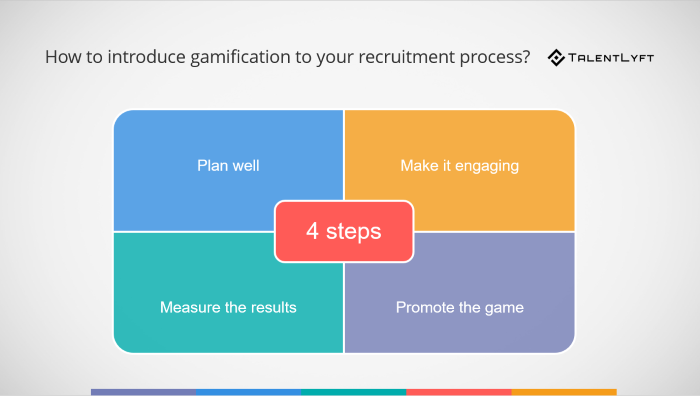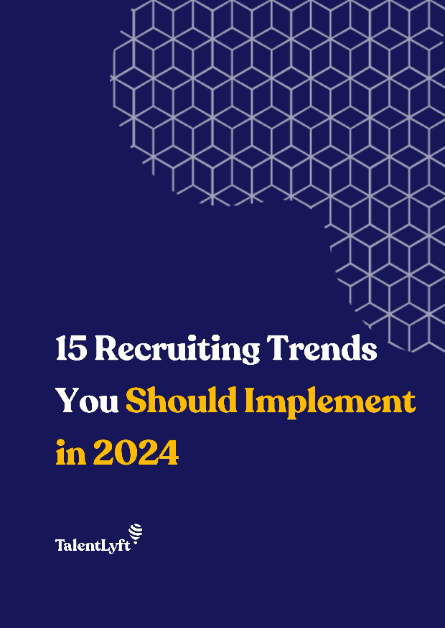![https://adoptostaging.blob.core.windows.net/article/4pdimGD4PkCVYbIoRrkiBA.png?1805]()
Gamification - a new fad or a viable recruitment strategy?
If you think that gamification is a new fashionable thing invented by marketers, then we want to surprise you. Yes, gamification is undoubtedly one of the top recruiting trends in 2021.
➡️ Download free eBook: 15 Recruiting Trends You Should Implement in 2021!
However, gamification has been accompanying us since childhood actually. At that time, for example, the whole process of our learning was gaming. We learned new words with the help of games, we learned the reading and writing by playing, and even in elementary school classes, this element was still present in our lives.
Those whom we used to consider as ‘children’ yesterday, today they have become graduates who either just get a job, or already have the first experience and want to develop a career further.
More and more articles are starting to flash on the Internet about generation Y people, who they are, what motivates them, how to make them work, how to retain them at the workplace and how to attract them to your company in the first place.
Gamification is a key trend in the interaction with the new ‘child prodigies.’
Seth Pribach, the founder of SCVNGR, said in an interview:
If you let your employee be an 80th level elf, he or she will work much more efficiently.
Reviewing this article, you can find out how to find the right job candidates with the help of gamification.
What is gamification in recruitment?
If you define it, then gamification is an introduction of gaming strategies into non-gaming processes.
Supporters of gamification in recruitment suggest that this scheme can be used for the benefit of a business. Introducing elements of the game in the process of interaction with their employees and even with customers, people can increase their loyalty to the company.
Moreover, the employees will be more productive for the company due to gamification. A vivid example of this scheme is the bracelet from Nike, which calculates the level of activity of a person during the day, allows you to share your success with others.
Why do you need gamification?
The generation of people who had a computer at home (and, of course, games) did not just grow up, but also took a worthy place in life. Their motivation from early childhood was built not on duty and correctness, but on enthusiasm and reward.
The fact is that all these people (and the hundreds of millions that are playing right now) perfectly understand what levels are, pumping, quests, rewards, achievements. These people cannot understand completely what the owner expects from them or how to receive the most from your service. They already instinctively pump their level, develop skills, perform tasks and set records. This must be used as one of the most effective recruiting strategies to attract the top young talent.
Look at the games for the past 10 years:
● Now they are much more diverse, somewhat more bold, somewhat softer.
● They covered the audience more than 10 years ago.
● Get more attention than 10 years ago.
● And they earn more money than 10 years ago.
It's time to change our jobs, our English courses, our sites, our online stores. Applications on mobile have already changed, they are often as cool as games. Gamification is a way to re-invent everything that does not really work.
Pros and cons of using gamification in recruitment
If you have a candidate with well-written CV who successfully passed the interview, it is not the guarantee that you’ve found the best person for the job. Unfortunately, that same candidate may not have the practical skills at work. This is where gamification comes in.
Very often employers are looking for motivated and active employees. To find exactly such people they can often use gamification. The undoubted advantage of this technique is that in this way it can be seen whether the potential employee will cope with his duties.
But not everything is so simple. The huge drawback of gamification is the human factor. Agree, not all truly talented people can be ready for such technique.
As you see, there are pros and cons to gamification in recruitment.
Best practice examples: How do companies using gamification to attract the best talent?
We want to consider several examples of companies using gamification to attract the best talent. Here are the top 3 examples of companies and organizations using gamification in recruitment:

Example #1: US Army
The US Army recruits people with the help of Virtual Battlespace, which is essentially a simulator of military operations. The best players get an offer to work on the basis of their game rating. It a great example of using skills assessments to enhance a company’s employer brand.
All over the world, IT companies are increasingly organizing similar thematic tournaments, such as ‘The Hackers' Night Crazy Snake Edition,’ where, in one place a lot of qualified developers immediately gather.
Organizing similar events facilitates the work of recruiters in the search for IT professionals and alleviates tech recruiting.
Example #2: Marriott
The hotel chain Marriott International has created an application on its Facebook page like ‘Farmville’ and ‘The Sims’, in which you have to try yourself as a manager of a hotel.
The goal of the game is to draw attention to the hotel business and to popularize it in those countries where the network is going to open new hotels.
It is a great example of how companies can use social media to promote their employer brand and find the best candidates.
Example #3: Sodexo
Sodexo, a food and service company, has created the QueSocial platform. Employees of the company create their accounts on this platform, which are integrated with their profiles on social networks. The platform is used for sending corporate news, informing about the actions and activities of units, new vacancies, etc. Those who are registered on QueSocial receive this newsletter via SMS or e-mail. Every piece of news has a title, a short description, and a link.
All links are tracked and transferred to a special panel to which recruiters have access. It shows the activity metric by links; frequency of clicks, number of reposts, etc. The data can be used to encourage employees to support various corporate topics, analyze their interests.
As a result, this platform turns into an excellent tool for promoting your company culture in order to attract new talent. Using simple game mechanics in the process of working with staff, employees become active representatives of the company and its brand.
How to apply gamification in your recruitment process?
If you’re interested to learn how you can apply gamification to your own recruiting strategy and attract top talent, check out our article How to Use Gamification in Recruitment?
In this article, you’ll learn how to introduce gamification to your recruitment process in 4 easy to follow steps:

Conclusion: Gamification is a new successful trend in recruitment
Gamification can be defined as the application of elements, technologies, and practices of games to various spheres of life and activity.
Gamification quickly spreads to virtually all areas of our lives. No exception was the gamification in recruitment. Elements of gamification are introduced by commercial companies on a fairly haphazard basis with the aim of improving business processes and improving performance.
Without any doubt, gamification is a new successful trend in the selection and hiring of staff - one of the top great recruiting hacks you can implement to accelerate your hiring in 2021!
About the author
Susan Wallace has a master's degree in journalism and mass communication from New York University and holds the certified employee benefits specialist (CEBS) accreditation. She formerly held editorial positions at the Essayontime.com. Her areas of expertise are in training and development, ethic and leadership development.


















